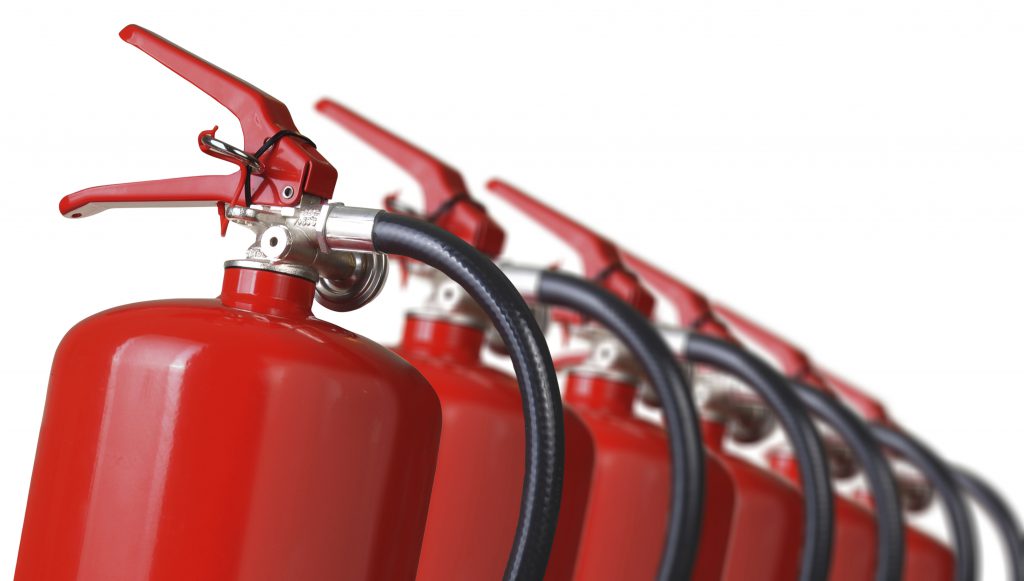In the event of a fire, preparation is paramount.
Fires can occur for a number of reasons, with each class of fire bearing its own particular set of properties.
As a result, it’s crucial that the correct type of fire extinguisher is used.
To ensure that you’re ready if a fire occurs, this article will delineate the differences between the five main categories of fire extinguishers, and the six classes of fire for which they are designed to fight.

Classes of Fire and their Corresponding Causes
As previously stated, there are six classes of fire. These are as follows:
- Class A – fires caused by ordinary combustible materials such as wood, paper, fabric and refuse.
- Class B – fires caused by flammable liquids such as petrol and diesel.
- Class C – fires caused by flammable gases such as propane and butane.
- Class D – fires caused by combustible metals such as magnesium, lithium and aluminium.
- Electrical (Class E) – fires caused by electrical apparatus.
- Class F – fires that predominantly occur in a kitchen which involve cooking oil, fats and grease.
The Different Types of Fire Extinguishers
So, although all fires may appear to be of the same kind, they are in fact triggered by, and composed of, a variety of materials.
In what follows, this article will outline individually the five types of fire extinguishers, their respective colour-coding, and the classes of fire for which they are best suited to fight.
Water Extinguishers (Red)
Water extinguishers are best suited to fight Class A fires, those fueled by wood, paper or fabric, and should not be used on live electrical apparatus. They are highly cost-effective and break down into a variety of sub-categories.
Namely, water jet, spray mist and fog.
Water mist extinguishers, a new technology, are arguably the most versatile type of fire extinguisher, proving effective to varying degrees against all classes of fire.
Foam Extinguishers (Cream)
Foam extinguishers are extremely useful in combatting Class B fires, as the thick layer of foam delivered by these extinguishers guards against reignition.
They are also able to tackle Class A fires effectively, but should be avoided in the case of cooking related fires.
Carbon Dioxide Extinguishers (Black)
CO2 extinguishers are capable of fighting Class A fires, but are particularly good at fighting Class E fires, arguably the most delicate class of fire to deal with due to the various potential dangers.
This makes them the perfect fit for office extinguishers, offering great protection against computer-related fires. On top of this, CO2 extinguishers are one of the cleanest varieties, as they leave little to no residue.
Be careful operating CO2 extinguishers in confined spaces, though, as their fumes could cause harm.
Wet Chemical Extinguishers (Yellow)
Wet chemical extinguishers were designed specifically to fight Class F fires, those involving cooking products and byproducts such as oils and fats.
This makes them perfectly suited for large restaurant kitchens where such fires have a propensity to occur. It should be noted, however, that some wet chemical extinguishers can combat Class B fires and some cannot; this varies from manufacturer to manufacturer. Just remember – always check the label!
Powder Extinguishers (Blue)
Powder extinguishers are perfect for mixed-risk environments, offering good all-round protection save for kitchen-related fires. What’s more, they offer great (and a fairly unique) defence against Class C fires, those fuelled by flammable gases.
Protect & Detect is a leading fire safety and security company, servicing Ipswich, Colchester, Cambridge, Bury St. Edmunds, Chelmsford and beyond.
Protect & Detect offers a wide range of fire safety and security services including; fire alarms, fire extinguishers, burglar alarms, intruder alarms, fire sprinkler systems, access control, door entry systems, CCTV, barriers, nurse and warden calls. Contact our friendly team today for a quick quote.

